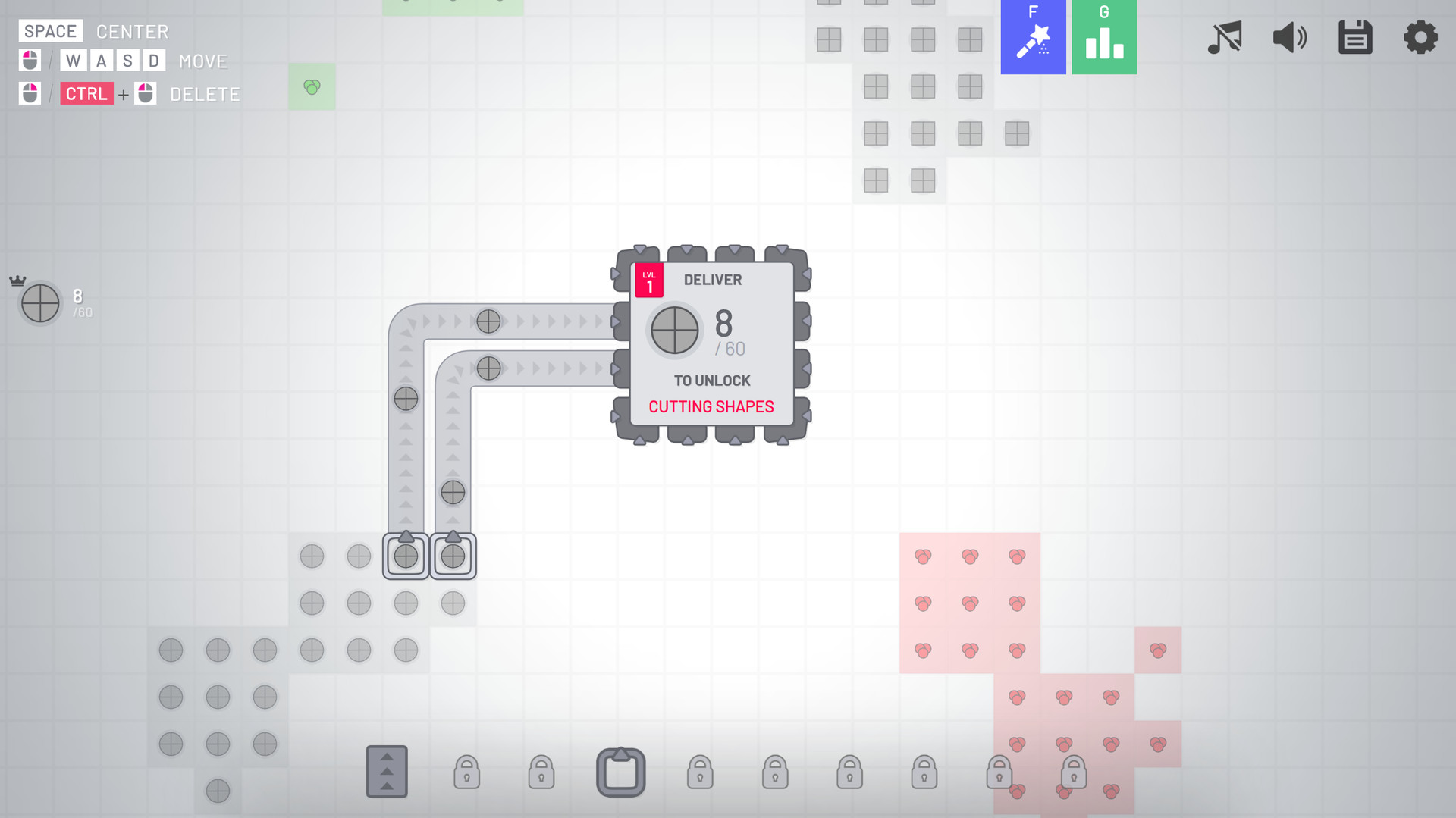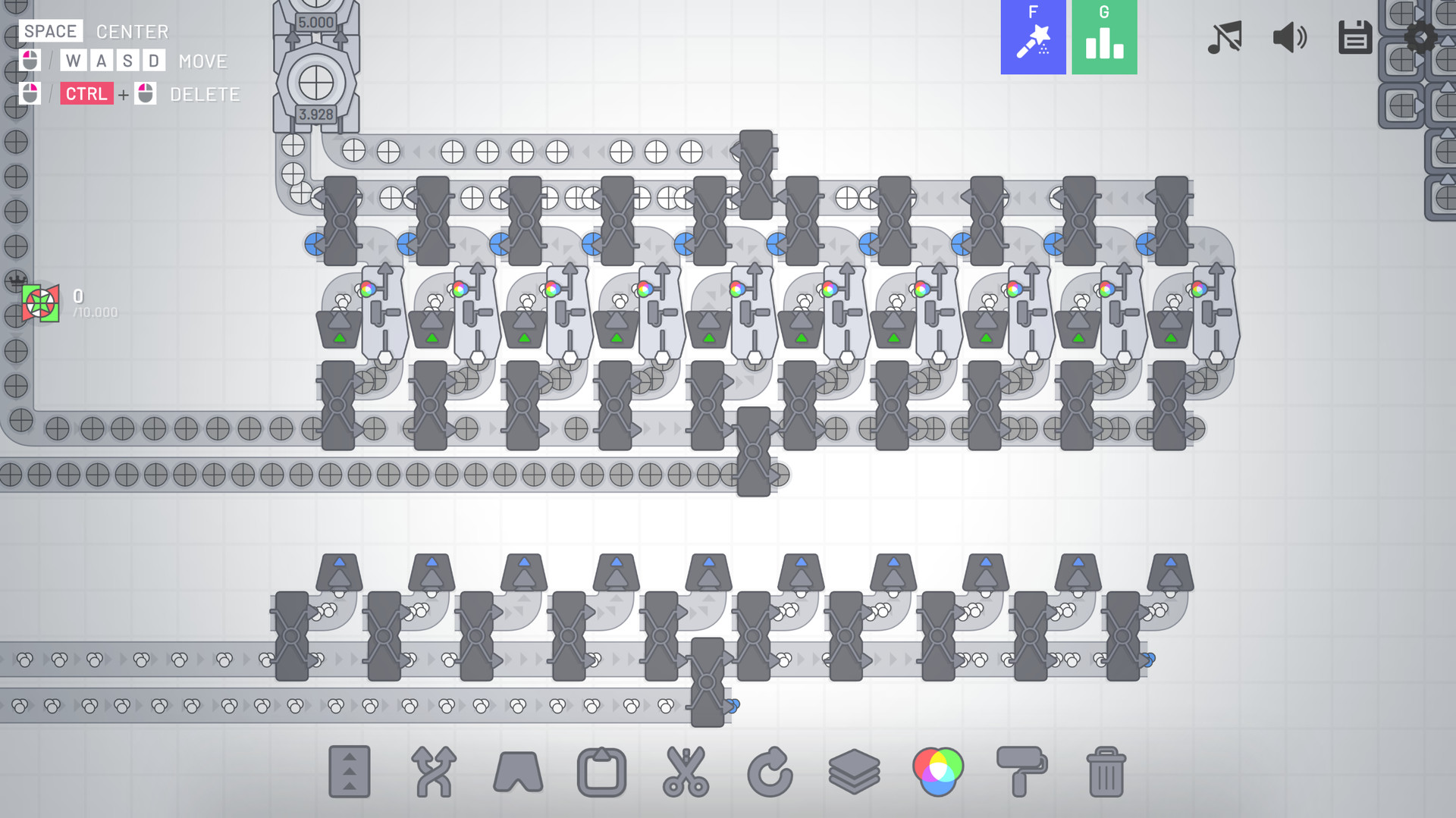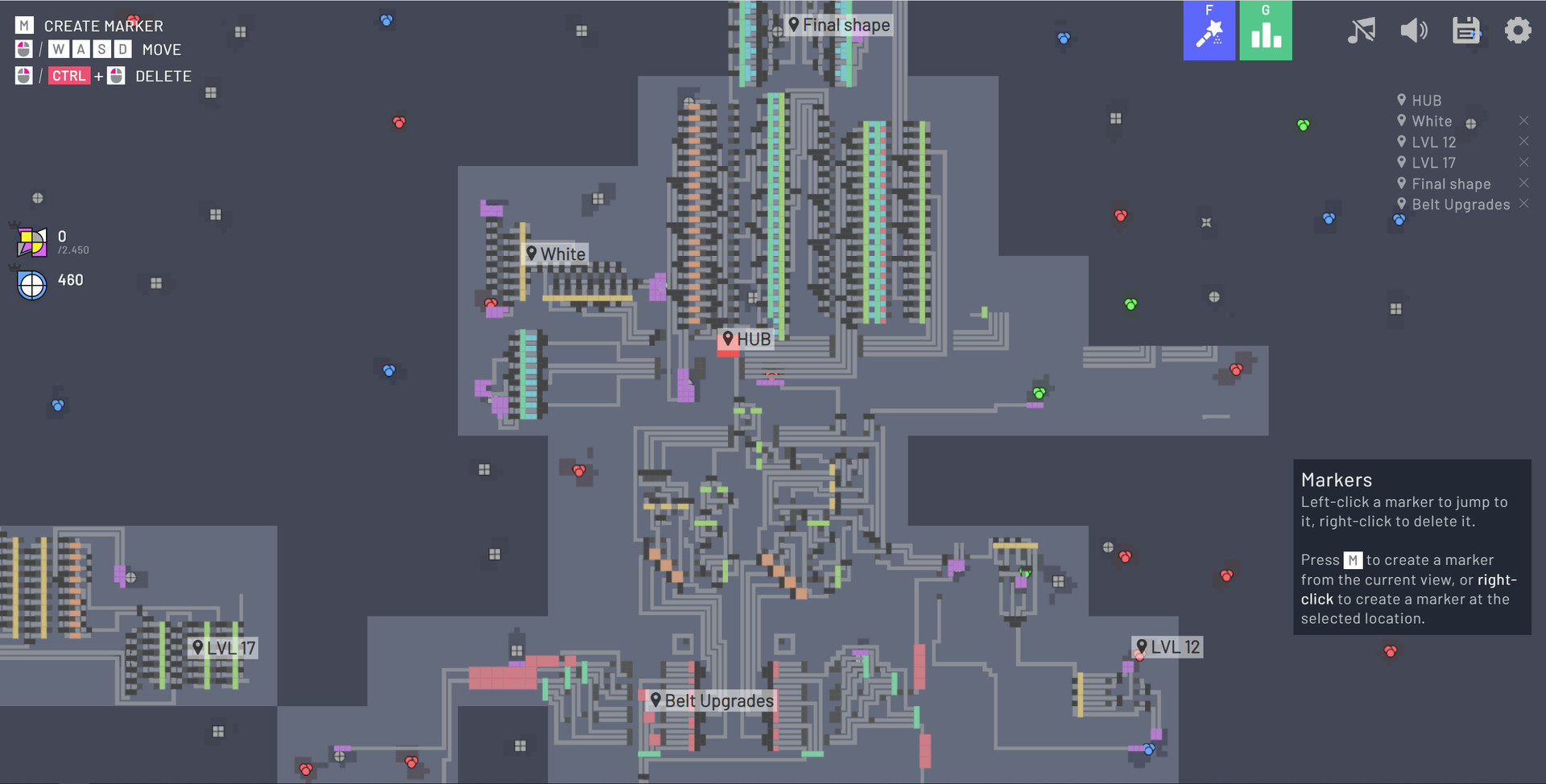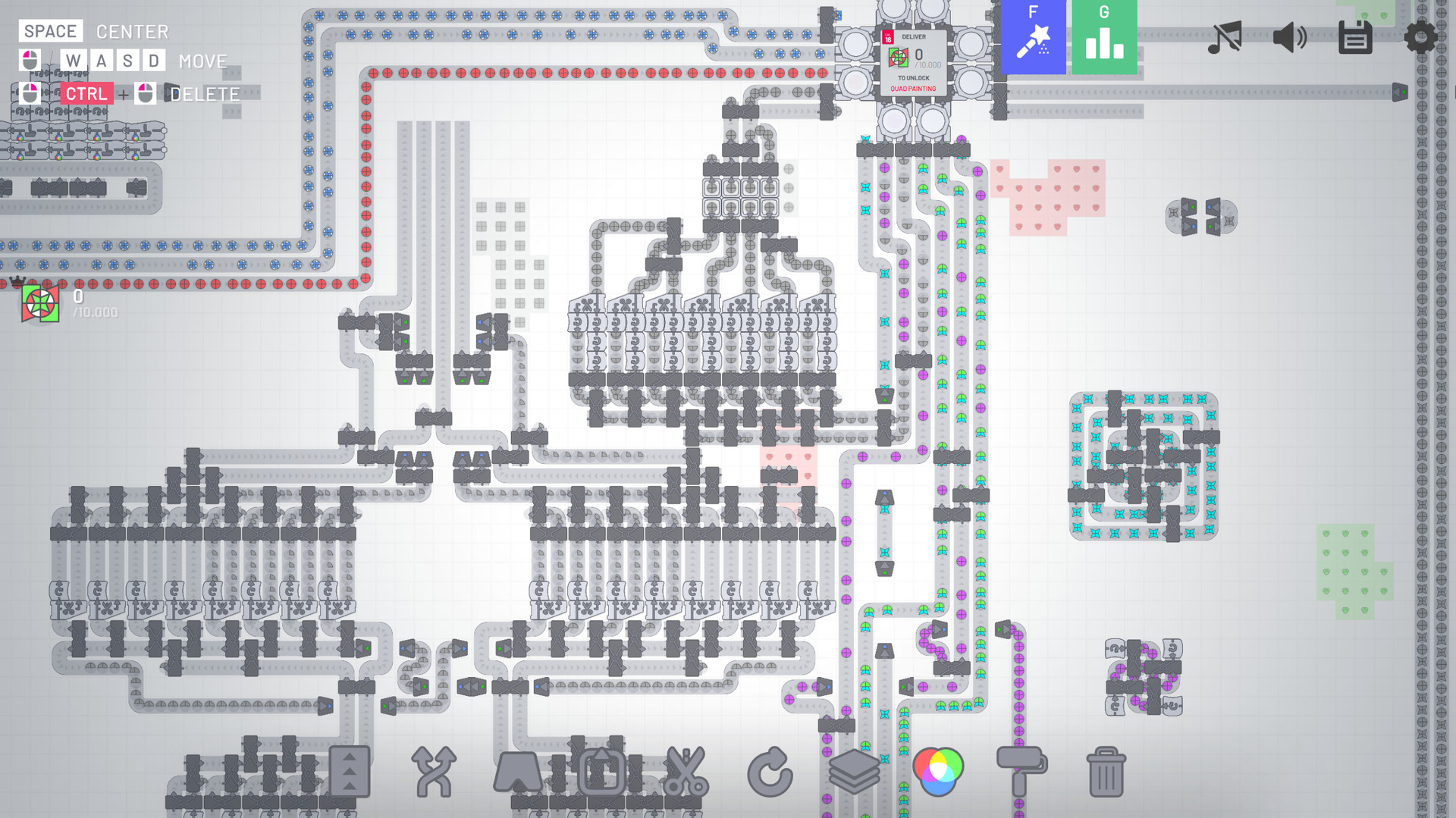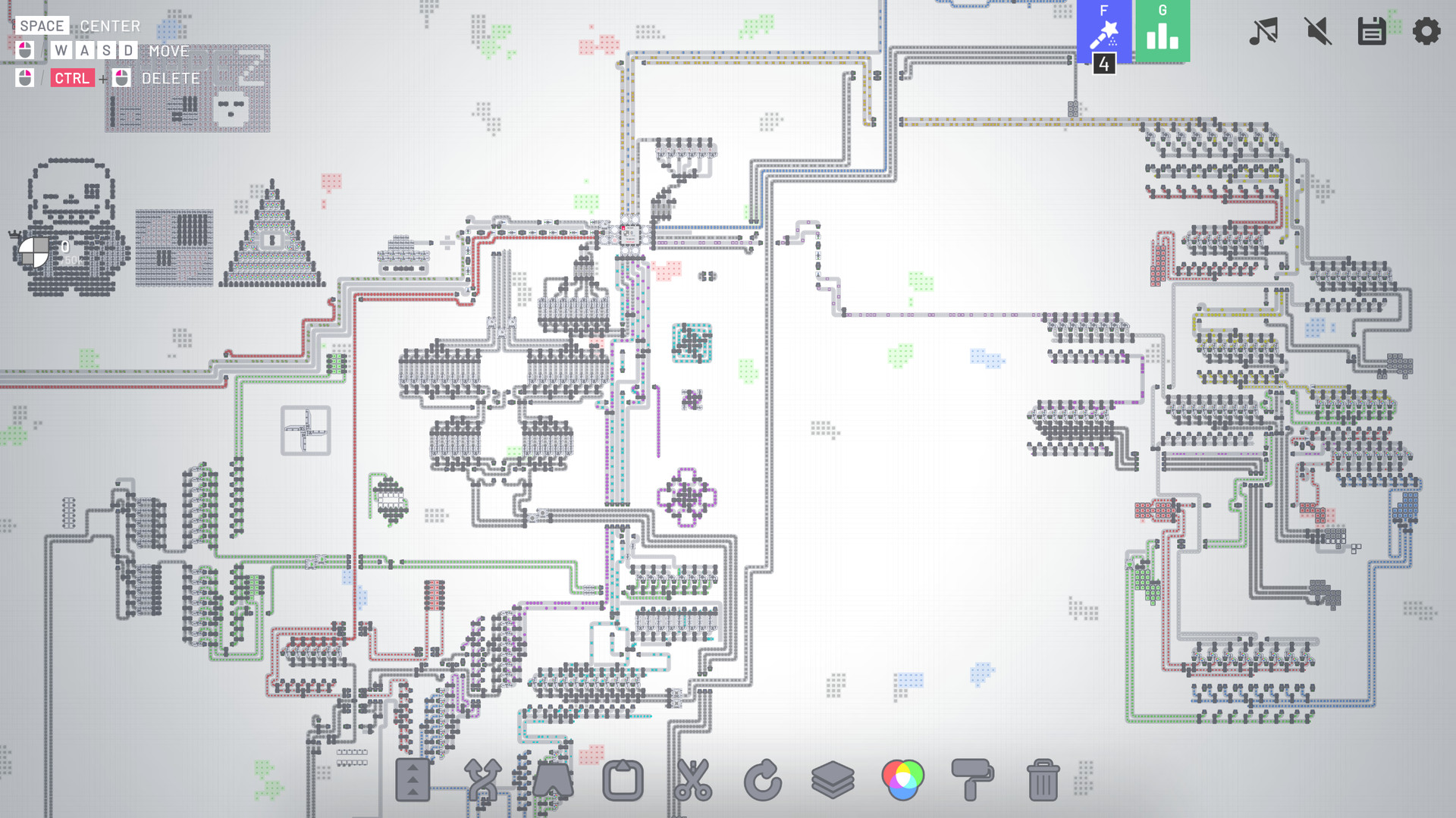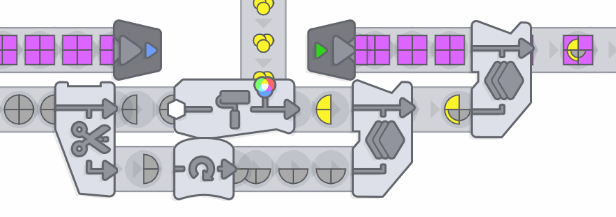
shapez.io is a game about building factories to automate the creation and combination of shapes. Deliver the requested, increasingly complex shapes to progress within the game and unlock upgrades to speed up your factory.
Since the demand raises you will have to scale up your factory to fit the needs - Don't forget about resources though, you will have to expand in the infinite map!
Since shapes can get boring soon you need to mix colors and paint your shapes with it - Combine red, green and blue color resources to produce different colors and paint shapes with it to satisfy the demand.
This game features 18 levels (Which should keep you busy for hours already!) but I'm constantly adding new content - There is a lot planned!
Standalone Advantages
- Waypoints
- Unlimited Savegames
- Dark Mode
- More settings
- Allow me to further develop shapez.io ❤️
- More features in the future!
This game is open source - Anybody can contribute! Besides of that, I listen a lot to the community! I try to read all suggestions and take as much feedback into account as possible.
- Story mode where buildings cost shapes
- More levels & buildings (standalone exclusive)
- Different maps, and maybe map obstacles
- Configurable map creation (Edit number and size of patches, seed, and more)
- More types of shapes
- More performance improvements (Although the game already runs pretty good!)
- Color blind mode
- And much more!
Devlog 020 - Space Belts
Not only do you get Devlog 020 today, Patreons also just got access to Alpha 20! This new build includes everything mentioned in this blog, plus a bunch of new features and visuals. Updated content includes train collision avoidance, simulation improvements, map generation improvements, new visuals for a couple of buildings and much more.
Just a reminder, everything shown in this blog is still in development and is still subject to change. They're not quite placeholders anymore, but the visuals of the Space Belts are not finished yet. Your thoughts and feedback are welcome, as always!
[hr][/hr]
Space Belts are an essential tool to transport large quantities of shapes between platforms. Ideal for short distances, they allow you to easily cross a gap or connect a train station to your factory for pickups or deliveries. However, their original design was quite different from what were working with now. Lets walk you through it!
 Old build
Old build
 Old build
Old build
 Old build
Old build
This system is what you saw in the demo and this is as expected something we got a lot of feedback on. Technically we couldve made more prebuilt versions to allow for more complexity, but it would still be clunky and not very pretty. We can do better.

Enter: Space Belts. Theyre huge belts that support up to 12 regular belts across 3 layers, move shapes way faster and retain the flexibility you expect from belts, all without needing platforms to build on! This makes Space Belts your best option to connect platforms over shorter distances. If you need to move something over long distances however, Trains are the better option.
 Shapes moving across the Space Belt
Shapes moving across the Space Belt

When there are Space Belts, you also need Space Pipes. With the recent fluid system rework, it became possible to transport fluids across notches with pipes. This then allowed us to make the prototype of the Space Belts younger brother, Space Pipes! These work identical to Space Belts, but move fluids instead of shapes and have a different look to reflect this. Have a look at the concept below.
 This may or may not be what it will actually look like
This may or may not be what it will actually look like
Now, youll likely come across a situation where youd like to place your Space Belt across a platform, without connecting to said platform. Thats where you connect a Space Tunnel to your Space Belt! However, keeping Space Tunnels and Space Belts separate doesnt make much sense anymore as they work closely together now. So, Space Tunnels now have a brand new visual that matches that of the Space Belts, theyre both part of the Space Belts category in the UI and Tunnels can now be integrated into the smart-placement tool.

Space Belts are already in a really good state, but there are some improvements yet to be made. As we just mentioned, the Space Tunnels still need to be integrated into the placement behaviour of Space Belts. Thats to say, Tunnels should automatically be placed when you drag a Space Belt across a platform.
We are already considering other ways of improving them even more, however: a topic that has come up internally is that merging or splitting across different factory lanes and layers in space is too troublesome for too small of a result. To make this easier, we are evaluating Merge/Split Balancers. These special space platforms would have one side that can receive up to 12 belts and another 36 split across 3 other sides. The Merger takes up to 36 input lanes and distributes contents evenly across up to 12, while the Splitter takes up to 12 input lanes and distributes the contents evenly across up to 36.
[hr][/hr]
Well, that's everything for now. The bottom line is that Space Belts should act similar to regular belts, but a lot bigger. Anyway, progress is going very well and we have plenty more to show, so we hope to see you again for the next devlog.
~ Tobias & the shapez 2 team
Hello everyone!
Last devlog we talked about trains , so let's look at your other option today: Space Belts. You'll likely be using these a lot, so let's take a look at what we're working with.
https://store.steampowered.com/app/2162800/shapez_2/
News
Devlog survey
We're really interested to learn if there are ways for us to improve the quality of the devlogs and/or align them more with what you'd truly like to know about shapez 2! This survey includes questions about quality, usage of visuals, your interests as well as a suggestion box where you can suggest topics for future devlogs. So whether this is your first devlog or you've already read all twenty(!) of them, we would really appreciate it if you could take the time to check out the survey![u]Fill out the survey here![/u]
Alpha 20
Not only do you get Devlog 020 today, Patreons also just got access to Alpha 20! This new build includes everything mentioned in this blog, plus a bunch of new features and visuals. Updated content includes train collision avoidance, simulation improvements, map generation improvements, new visuals for a couple of buildings and much more.
Disclaimer
Just a reminder, everything shown in this blog is still in development and is still subject to change. They're not quite placeholders anymore, but the visuals of the Space Belts are not finished yet. Your thoughts and feedback are welcome, as always!
[hr][/hr]
A brief history
Space Belts are an essential tool to transport large quantities of shapes between platforms. Ideal for short distances, they allow you to easily cross a gap or connect a train station to your factory for pickups or deliveries. However, their original design was quite different from what were working with now. Lets walk you through it!
Just build it yourself!
Initially, you were expected to build connections using these platforms manually. You would place platforms and then build belts and launchers on them to create connections. It quickly became obvious that this is very burdensome to do all the time for every connection (as you may expect), so we started working on improvements. Old build
Old buildSpace Tunnels
One of the first improvements was the addition of special tunnel platforms. These allowed your connections to transport shapes under other platforms, making connecting across sections much easier. Additionally, their ability to consistently transport large quantities of shapes essentially made them function as Space Belts, but without the flexibility of seamlessly splitting and merging. The tunnels exist as their own form of transport alongside the buildings you know from shapez 1, as well as Shape Launchers. Old build
Old buildHyperbelts
The first step towards improving space platform connections was Hyperbelts. Despite the fancy name, it was just a tool that allowed you to easily place prebuilt versions of the space platforms with belts & launchers without having to build all of it yourself. It was based on the idea of belt placement in your factory, but very simplified - it didn't support merging or splitting unless you manually made platforms to do so. Old build
Old buildThis system is what you saw in the demo and this is as expected something we got a lot of feedback on. Technically we couldve made more prebuilt versions to allow for more complexity, but it would still be clunky and not very pretty. We can do better.
Space Belts
With a ton more feedback under our belt, the Hyperbelts flaws became clearer and clearer. Aside from the lack of complexity we already mentioned, it was also just very slow. They moved shapes at the same speed as all other belts in your factory, and when youre crossing larger distances, it really did take a while before your shapes got anywhere. Essentially, what we needed was a system that had all the functionality of regular belts, but much larger, faster and independent of platforms. So, we made just that.
Enter: Space Belts. Theyre huge belts that support up to 12 regular belts across 3 layers, move shapes way faster and retain the flexibility you expect from belts, all without needing platforms to build on! This makes Space Belts your best option to connect platforms over shorter distances. If you need to move something over long distances however, Trains are the better option.
 Shapes moving across the Space Belt
Shapes moving across the Space Belt
When there are Space Belts, you also need Space Pipes. With the recent fluid system rework, it became possible to transport fluids across notches with pipes. This then allowed us to make the prototype of the Space Belts younger brother, Space Pipes! These work identical to Space Belts, but move fluids instead of shapes and have a different look to reflect this. Have a look at the concept below.
 This may or may not be what it will actually look like
This may or may not be what it will actually look likeMerging with Tunnels
For close-distance transport, we would now have both Space Tunnels and Space Belts & Pipes. The key difference between the two is that Tunnels can move shapes under a platform, bypassing it without slowing down. However, they can only go straight and have a range of 4 chunks, which is where Space Belts and Pipes come in.Now, youll likely come across a situation where youd like to place your Space Belt across a platform, without connecting to said platform. Thats where you connect a Space Tunnel to your Space Belt! However, keeping Space Tunnels and Space Belts separate doesnt make much sense anymore as they work closely together now. So, Space Tunnels now have a brand new visual that matches that of the Space Belts, theyre both part of the Space Belts category in the UI and Tunnels can now be integrated into the smart-placement tool.

Whats next?
Space Belts are already in a really good state, but there are some improvements yet to be made. As we just mentioned, the Space Tunnels still need to be integrated into the placement behaviour of Space Belts. Thats to say, Tunnels should automatically be placed when you drag a Space Belt across a platform.
We are already considering other ways of improving them even more, however: a topic that has come up internally is that merging or splitting across different factory lanes and layers in space is too troublesome for too small of a result. To make this easier, we are evaluating Merge/Split Balancers. These special space platforms would have one side that can receive up to 12 belts and another 36 split across 3 other sides. The Merger takes up to 36 input lanes and distributes contents evenly across up to 12, while the Splitter takes up to 12 input lanes and distributes the contents evenly across up to 36.
[hr][/hr]
Well, that's everything for now. The bottom line is that Space Belts should act similar to regular belts, but a lot bigger. Anyway, progress is going very well and we have plenty more to show, so we hope to see you again for the next devlog.
~ Tobias & the shapez 2 team
Join the community:
X / Twitter YouTube Discord Reddit TikTok Patreon[ 2024-05-02 15:01:08 CET ] [Original Post]
GAMEBILLET
[ 6420 ]
FANATICAL
[ 7154 ]
GAMERSGATE
[ 3653 ]
MacGameStore
[ 5363 ]
FANATICAL BUNDLES
HUMBLE BUNDLES
by buying games/dlcs from affiliate links you are supporting tuxDB

